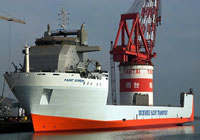Exports to help US economy avoid coming recession and collapse
After the news that company payrolls dipped in August for the first time in four years, forecasters are raising the odds on a U.S. recession. But the economy may have an ace in the hole. Foreign trade has become increasingly important to economic growth. Over the past year, a narrowing U.S. trade deficit made the largest contribution to growth in 14 years, and the pattern is likely to continue well into 2008.

The housing recession and tighter credit conditions may even accelerate that trend: As U.S. demand slows, so will imports. At the same time, solid growth overseas and a new downturn in the dollar will continue to power U.S. exports, and that will boost U.S. manufacturers' revenues and profits. In fact, this may well mark the beginning of the long-awaited realignment of global growth that will rebalance trade and capital flows between the U.S. and the rest of the world.
Speaking on global trade imbalances, Federal Reserve Chairman Ben S. Bernanke said in Berlin on Sept. 11 that he saw signs of progress but noted that the process will be slow.
"Most countries have only just begun to undertake the policy changes that will be ultimately needed," he said. More progress is necessary in both private and government saving in the U.S., in combination with structural economic reforms in many areas outside the U.S.
Since the late 1990s, the U.S. has been consuming more than it has been producing to an ever-rising degree, as reflected in the ballooning current account deficit, the broadest measure of U.S. obligations. Last year the gap, comprising the trade deficit and some other financial transactions, had risen to a record 6.2% of gross domestic product, from a mere 2.5% in 1998. Totaling $811.5 billion last year, the chasm between U.S. consumption and production required an equal amount of foreign capital to finance.
The great potential for an even narrower trade gap in 2008 shows up in the relative growth rates for exports and imports so far this year. Through July, real exports of goods have grown 7.7% from the same period the previous year, while imports are up 2.4%. Consider that because imported goods are more than 60% greater than exports, the growth rate of exports has to be at least 60% faster just to hold the deficit steady. Until last year, that was a tough hurdle. But so far this year exports are growing more than three times faster than imports.
The fuel under exports comes from a robust global economy and a competitive dollar, and both factors will continue to offer support. In early September the trade-weighted dollar hit a record low against a basket of major currencies, and hovered near a 10-year low vs. all trading partners. That drop has effectively cut the price of U.S. products in foreign markets, while making imports more expensive in the U.S.
Heading into 2007, the greenback had fallen 18% against all currencies since its peak in early 2002, and since the beginning of this year it's down an additional 4.1%. Two factors that tend to increase the attractiveness of assets outside the U.S. argue for a further decline: Growth prospects abroad continue to look brighter than in the U.S., and the Fed appears set to reduce interest rates while other central banks are in a holding pattern. And the prospects overseas are for further increases as the credit crisis abates, businessweek.com reports.
One of the evidence that exports could play a crucial rolein the future development of the US economy is the fact that Indians in pursuit of the American dream need no longer cross the seven seas. In fact, they can do it from home itself, as nine of the top 10 American companies to launch a career with are present here.
Global accounting and consultancy giants Deloitte & Touche, PricewaterhouseCoopers (PwC) and Ernst & Young, IT major IBM and Internet search giant Google have emerged as the top five career launchers in the United States, according to a study by finance magazine BusinessWeek. These are followed by software major Microsoft, entertainment giant Walt Disney, IT consultancy major Accenture, defence equipment maker Lockheed Martin and Teach for America, a non-profit organization.
Excluding Teach for America, all firms have a noticeable presence in India in terms of headcount and are in the process of further expanding in the years to come.
BusinessWeek's September 24 issue has a total 95 such companies. Nearly half of them have a significant part of their workforce in India while a number of others are understood to be working on making a presence in the country. Besides, nearly all of those already in India are expected to substantially expand their workforce here.
Other firms on the list with a sizeable India presence include Intel, Cisco, Goldman Sachs, Johnson and Johnson, Lehman Brothers, Hewlett-Packard, Dell, Motorola, Unilever, JP Morgan, Careerbuilder.Com, Merrill Lynch, KPMG and Prudential.
India already accounts for IBM's largest workforce outside the US while the Indian strength of Accenture is expected to soon surpass its US headcount.
Deloitte plans to augment its India headcount to 12,000 by 2010. PwC, which has 12 offices in different Indian cities, is expected to nearly double its headcount from 4,500 in the next four years. E&Y, with nine offices, also has more than 1,500 employees in India, Excluding Teach for America, all firms have a noticeable presence in India in terms of headcount and are in the process of further expanding in the years to come, hindustantimes.com reports.
As Pravda.Ru previously reported The U.S. dollar is standing at the edge of a cliff, and most people don’t even know it.
Data released by the New York Federal Reserve shows that foreign central banks have been net sellers of U.S. treasuries over the past five weeks, with $48 billion having been sold since late July, and $32 billion in just the last two weeks.
The U.S. runs budget deficits each year. If foreigners stop buying treasuries—or worse, start selling them—the dollar could be in big trouble.
The reduction in treasuries “comes as a big surprise and it is definitely worrying,” said Hans Redeker, foreign exchange strategy chief at bnp Paribas, one of Europe’s biggest banks.
The Telegraph reported that, according to Redeker, the numbers demonstrate “that world central banks are in a hurry to get out of the U.S.”
The nation that analysts are watching especially closely at this stage is China. Whether or not Beijing is selling its dollars can’t be officially confirmed until November, when the Treasury releases its tic data. However, top Beijing officials have been signaling for at least two years that dollar sales are increasingly imminent.
Source: agencies
Prepared by Alexander Timoshik
Pravda.ru
Subscribe to Pravda.Ru Telegram channel, Facebook, RSS!


